Bougainvillea Tree Bonsai Ultimate Species Guide
The Bougainvillea tree is one of the most beautiful specimens to grow as a bonsai. While it’s native to South America, it’s located in several countries worldwide, such as the United States, United Kingdom, and South Africa. What makes them unique are the unique leaves known as bracts that many people mistake for flower petals.
In this ultimate Bougainvillea guide, we’ll show you how to care for it and cultivate it as a bonsai tree.
Here are the topics in this article:
Here are the topics in this article:
01
02
03
04
05
06
07
Quick Bougainvillea Bonsai Care Sheet
If you don’t have much time to read through our detailed guide, we have a quick TL;DR for you to peruse. It contains fast facts to consider when caring for a Bougainvillea bonsai, but feel free to read further for more details.
Recommended soil
Standard mix that drains quickly
Watering
Summer: daily; winter: twice a week
Potting season
Spring, every 2 – 3 years
Shaping and pruning season
Late winter: basic structure; Spring: maintenance trimming
Light
Summer: full sunlight outside; winter: indoors with sufficient light
Humidity
High humidity
Fertilizing
Twice a week in winter; once a week the remainder of the year
Propagation methods
Cuttings work the best, but air layering is a possibility
Pests and diseases
Resilient against pests and disease if kept strong and healthy
Growth patterns
It sprouts well from hardwood and grows like a vine
Recommended styles
Several styles that work include formal and informal upright, cascading, and slanting
Native Area
South America
Scientific Classification
Before we show you how to care for the bonsai, let’s take a quick look at the Bougainvillea scientific classification:
- Clade: Eudicots
- Order: Caryophyllales (carnation)
- Family: Nyctaginaceae (four o’clock)
- Genus: Bougainvillea
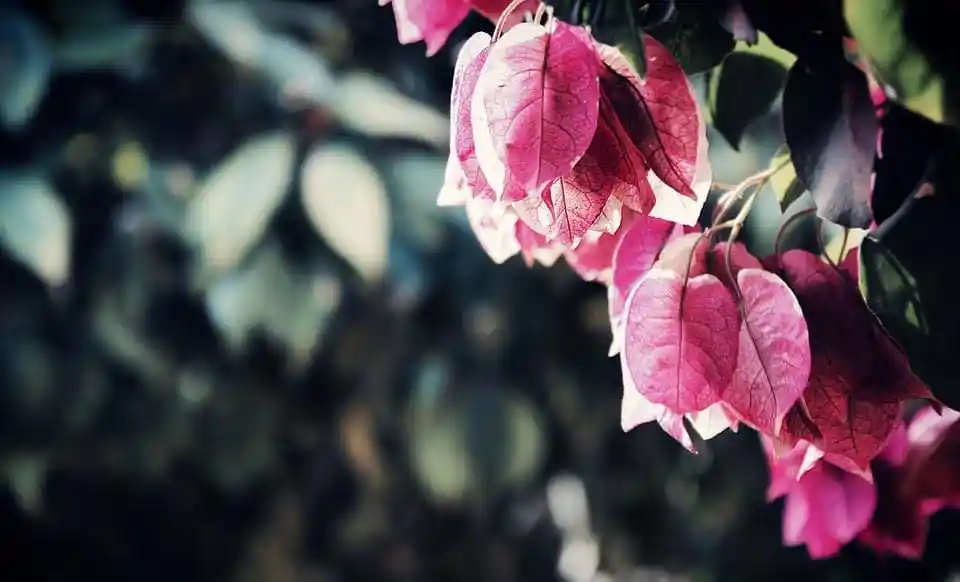
Bougainvillea Care Guide
Let’s get into the heart of our Bougainvillea tree guide for bonsais! We have several sections to discuss with you regarding its care, as it will help it grow sturdy and strong. We’ve gone into quite some detail to ensure you have as much information as you need.
Placement And Light
The first element we’ll discuss is placement and how much sunlight the Bougainvillea needs. We’ve received several questions about this before when we posted our previous article on social media. We’ll cover the most essential ones while also adding a few of our own to ensure you receive all the needed details.
Where Is The Best Place To Plant A Bougainvillea?
When it comes to location, the Bougainvillea thrives in full sun. It helps to create energy in the bonsai so that it can produce foliage and flowers. If you’re growing one in your garden, it helps to place a trellis for the vines to climb and spread, but you don’t need it for your bonsai tree unless you’re going for the same effect.
Is Bougainvillea an Indoor Plant?
You can grow the Bougainvillea indoors or outdoors, as it does well in both situations. You’ll need to ensure that it still receives full sun for at least six hours in the morning while there should be some shade during the peak afternoon to protect the leaves from burning.
Another factor to consider is that it loves humidity, so you’ll need to cater for it when you bring it indoors. Place it by a window that faces the sun in the morning or late afternoon, and check that it’s happy with the location after a few days.
Does Bougainvillea Need Direct Sunlight?
If you want your Bougainvillea tree to create the best bonsai flower show anyone has seen, it needs several hours of direct sunlight. It uses this natural resource to make the energy needed for all the functions in its anatomy. When you supply it with water and food, the final ingredient to make every work as wonderfully as it should is sunlight.
Can Bougainvillea Grow In Shade?
If you plan on placing your Bougainvillea bonsai in partial shade for the entire day, it will survive. It can still use the dappled or low light to make the energy it needs, albeit it won’t be as much as it would like.
There are two primary concerns to housing the tree in only shade. The first is that it won’t be able to produce flowers, as it needs at least six hours of direct light every day for this task. Secondly, you may be encouraging mold to form if there’s high humidity and low light.
Can You Plant Bougainvillea Next To House?
Many people have bonsai stands, racks, and displays on the side of their house against the walls. It helps when you want only morning sun, and then the house delivers shade for the rest of the day while there’s still indirect sunlight.
The only issue with doing this with the Bougainvillea tree as a bonsai is when winter arrives. The cold often sticks to the walls and adds to lowering the temperature. If yours is pressing against the wall or creeping up, there’s a good chance the chilly surface may prove fatal to it.
What Can I Plant Next To Bougainvillea?
The plant poses no threat to others, and you don’t have to worry about any of them having a negative effect on your Bougainvillea bonsai. The only significant consideration we have is that you provide enough space so that it can expand without tangling on other leaves and flowers. You should also try and match the blooms with the colors of the other flowers around them.
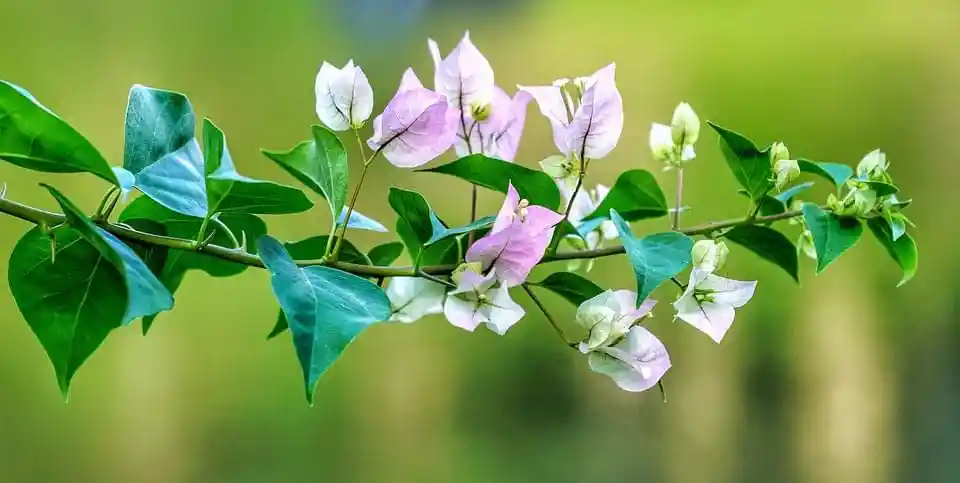
Wintering
One factor that most bonsais don’t enjoy is winter. When it becomes incredibly cold, your Bougainvillea may become a very unhappy tree, and it might look worse for wear after a few weeks. Ones in the wild do much better in these conditions, so you’ll need to give the potted version a bit more attention.
In this section, we’ll show you how to prepare it for the coming winter, which is one of the best ways to prevent it from dying. You’ll also see what else you can do when the cold sets in to make sure your Bougainvillea bonsai is completely happy. Then you can go to bed with a smile on your face.
When Should I Move My Bougainvillea Indoors?
When winter arrives and the temperature falls below 42° F, it’s time to bring your Bougainvillea tree inside. Be sure to still provide enough sunlight so it has the energy to do the minor tasks while going into dormancy.
How Do You Winterize Potted Bougainvillea?
Your Bougainvillea will go dormant in winter, but it will remain alive. To winterize your bonsai tree, you should remove all the leaves, as it won’t worry too much about absorbing sunlight. In this way, all the water stores in the stem for the next winter.
You can also place it in a dark room where it’s warm to protect it from frost or cold. You should also prune back the structure towards the design you want before the buds appear in the warmer seasons.
Should I Cover My Bougainvillea?
As an alternative to bringing your Bougainvillea bonsai inside, you can also cover the tree with a transparent bag. It will shield the stem while still keeping it outside if you want to give it some sunlight. However, you don’t need to worry if there’s too much shade.
You can also cover the soil with a thick level of mulch. It prevents the damp and frost from creeping into the soil and killing the roots. You’ll also save it from any mold or diseases forming, as long as you don’t overwater it in the winter.
How Do You Take Care Of A Potted Bougainvillea In The Winter?
Your greatest concern is not overwatering your Bougainvillea tree in winter. It will cause root rot and other problems, and it’s the quickest way to kill your sleeping bonsai. In the same light, don’t bother feeding it fertilizer, as it will only need the food once spring arrives. When the warmer season arrives, you can start increasing the watering.
Don’t worry too much if the leaves fall, as it will mainly be focusing on keeping the trunk and branches alive. You’ll want to spend the time doing some light pruning of the branches and twigs you don’t want. It’s stunning to do it at this time of the year, as it’s easier to see the structure.
What Temperature Is Too Cold For Bougainvillea?
Bougainvillea tree species thrive in zones 9b to 11. Any other areas may be too cold for the bonsai in winter, so it’s best to watch the temperatures. As a general rule, you should bring it inside when it hits 42° F. However, there are other levels that cause greater danger.
When it goes below 40° F, you’ll notice that the bracts and leaves start wilting. As soon as it reaches 32° F, your Bougainvillea bonsai is in danger of becoming damaged. It will be too cold for it to survive and transport any required nutrients.
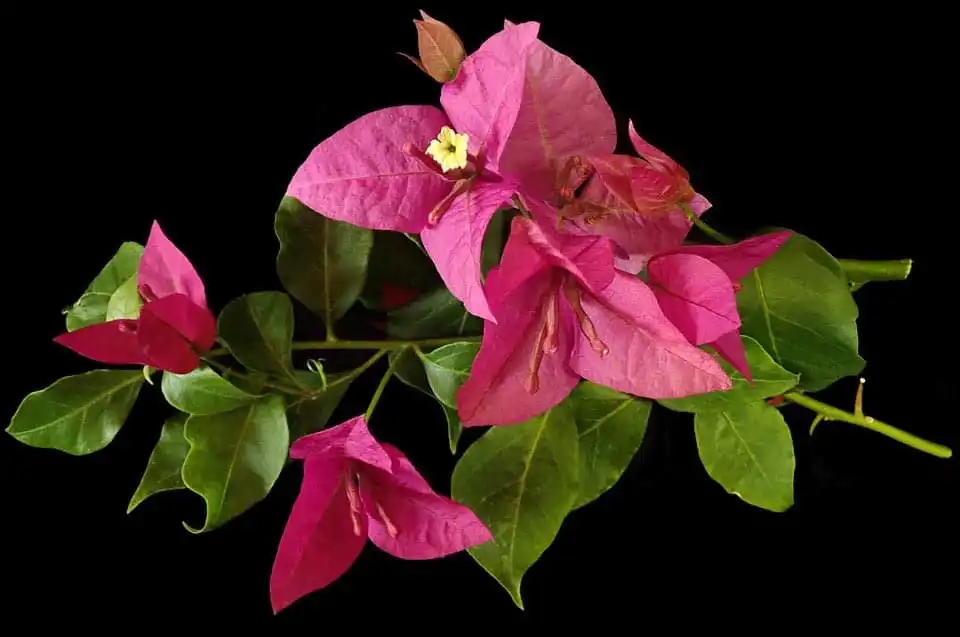
Watering
Next up on our list is watering which the Bougainvillea tree needs if you want it to thrive. You also don’t want to overwater it, as that also has its consequences. We’ll go into detail about each of these concerns, while you can also click on the links to read more details.
How Often Should I Water Bougainvillea?
Bougainvillea watering isn’t tricky once you have all the details. During the summer period, it becomes quite thirsty, so it will happily soak up liquid once a day. However, it’s more fond of a deep drowning once a month, which you can follow up with a light touch of water when the soil dries.
As soon as autumn arrives, you can start slowing down once a twice week and stop bathing the soil. In winter, you should only water when necessary, as overwatering can damage the roots.
What Does An Overwatered Bougainvillea Look Like?
If there’s anything that stresses a Bougainvillea bonsai tree more than anything else, it’s overwatering. While it isn’t much of a concern in summer, it becomes a significant issue in winter. When you overwater it, you’ll notice leaves changing color and falling off, and the roots will decay to leave a foul odor in the soil.
It’s always best to have adequate drainage for any bonsai, and not simply the Bougainvillea. If you see that the soil struggles to release the water, it may be time to repot the bonsai tree. You should also consider adding drainage rocks at the bottom so that the water doesn’t rest in the substrate.
How Do I Know If My Bougainvillea Needs Water?
If you want stunning flowers in summer, you’ll want the soil to dry out a bit before you bathe it in water. Your Bougainvilleas may look slightly wilted if they need water, and you can use a tray under the pot to see how quickly it drinks the precious liquid. Another method of testing is by sticking your finger or chopsticks in the soil to see how dry it is.
Don’t forget that the bonsai also loves humidity. If the air is dry in your region, you may want to consider a humidity tray or spraying the leaves. The latter isn’t encouraged, as the combination of the full sun and water droplets may cause the foliage and flowers to burn.
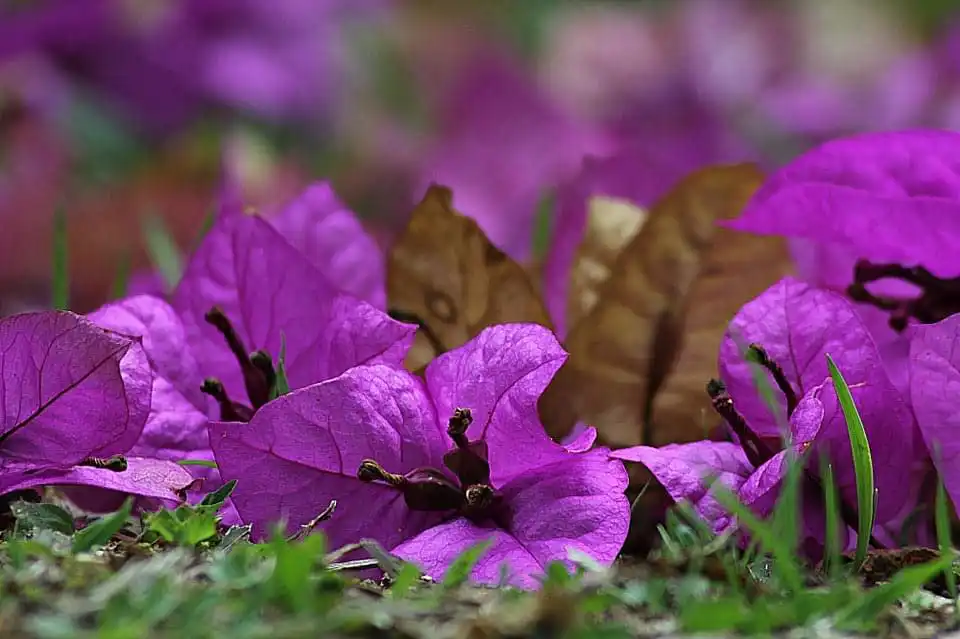
Feeding, Potting, And Soil
Together with watering, there are a few more aspects you need to check with your Bougainvillea tree. These three elements deal with the roots and soil, ensuring that your bonsai has sufficient stability and nutrients to thrive and flower. We’ll use a seasonal approach in some of them.
Can Bougainvillea Grow In Pots?
Since the Bougainvillea tree climbs and grows so large in the wild, many bonsai enthusiasts wonder if it will do well in pots. Surprisingly, the roots have no issues with it, as long as you repot it when needed.
It can often develop quite huge in pots, and you should complement the color by matching it with the flowers. If you’re placing it outside in the summer, make sure there’s a wall nearby to protect it from strong winds pushing it over.
Can Bougainvillea Grow In Small Pots?
If you plan on growing your Bougainvillea bonsai really small, you can use a tiny pot to control the spread of the roots. They tend to remain shallow, so you shouldn’t see them protrude through the drainage holes. You need to also trim the foliage as much as possible, which will prevent the roots from becoming too bulgy.
The only issue is that you may need to repot more regularly until the bonsai become mature. The roots will drink the water and nutrients quickly, while they’ll also take up the space in a relatively short time. You may need to transplant it at least annually for the first few years.
How Do You Care For A Potted Bougainvillea?
The same rules apply for caring for a Bougainvillea tree even as a potted bonsai. Of course, they have different settings in the garden or wild, such as drawing water from the ground whenever they need to and full access to the sun. So, the main differences are that you need to ensure it has enough sunlight, humidity, and water for the tree’s size.
One other factor you should consider is not moving it around too much. Once Bougainvilleas settle in a location, they don’t like changing to new conditions. Leave it to become used to the new area, and don’t stress too much if you see it losing leaves in the first few weeks.
Can You Replant Bougainvillea?
As long as the conditions are right, you can replant your tree into new soil or pot. When repotting Bougainvillea bonsais, ensure that you protect the roots at all times, as they are small and prone to break easily. The best technique is to dig a trench around the outer sides, pressing down and separating the soil from the container as much as possible.
When Should I Repot My Bougainvillea Bonsai?
The best time to repot your Bouganvillea tree bonsai is in early spring when you see the first leaves appear. As soon as these are fully developed, you’ve lost your opportunity to safely move it to a new container. You may cause it to stress that will lead to it dying or becoming damaged.
Some people feel it’s safe to transplant it in winter as the bonsai is sleeping. Unfortunately, this is a bad idea, as it won’t be ready to deal with any root damage or growth when you perform pruning. As it won’t be able to take in enough water and nutrients, it may not survive.
What Zones Can Bougainvillea Be Planted?
As long as you provide the right conditions, you can grow Bougainvilleas in any hardy zone. In general, it’s more suited for zones 9 to 11, as these are less likely to become too cold or develop frost that will kill the roots and foliage. If you live in any regions below these zones, protect your bonsai tree as mentioned earlier.
What Kind Of Fertilizer Do Bougainvillea Need?
To ensure that your Bougainvillea tree has enough food for the leaves, trunk, and flowers, you should provide a balance of nitrogen, phosphorous, and potassium (NPK) to the soil. You can use ratios of 5:5:5 or 10:10:10, as long as the numbers are the same. If you give too much nitrogen, you’ll see more green foliage than flowers.
There are two types of fertilizer you can give your bonsai. The first is a fast-release liquid form that you dilute in water and provide once a week over spring and summer. Secondly, you can try slow-release pellets that will take a few weeks to dissolve. Both are acceptable for Bougainvilleas.
Do Bougainvillea Like Coffee Grounds?
Two benefits of coffee grounds are that they raise the acidity level of the soil while providing more nitrogen. If you’re looking for healthier leaves, then this is the way to do it. You’ll see fewer flowers in the spring, but the foliage will improve as the season continues.
While the Bougainvillea will enjoy the acidic pH level, it may not be too find of the raised nitrogen. Also, there’s the chance that the coffee grounds will become moldy, which will cause problems in the soil. You’ll need to keep a close eye on it, but we don’t recommend you use this method to fertilize your bonsai tree.
What Soil Is Best For Bougainvillea?
If you use loamy soil that’s rich in nutrients, your Bougainvillea will be happy. You can also make your own mixture if you don’t trust the one your local shop sells. All you need to do is place organic compost, native soil, and loam soil in equal proportions in your pot.
You should steer clear of high peat moss levels, as it will retain moisture and cause root rot to occur. You can also use pine bark if you’d like while adding some drainage rocks at the bottom to prevent water from clogging the soil.
Can I Use Cactus Soil For Bougainvillea?
You can benefit from encouraging your Bougainvillea tree to extend its roots deeper into your pot, especially if you have a tall container instead of a shallow one. To do so, you can use cactus soil instead of the regular bonsai mix. What happens is that the water drains quicker than normal, so the roots will hunt deeper into the substrate to find it.
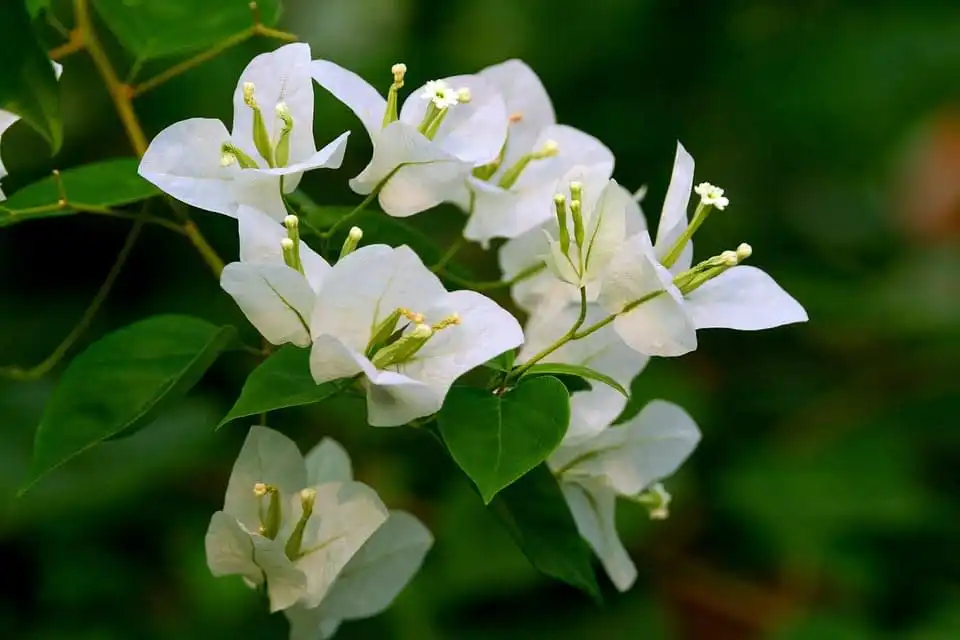
Flowers
Now with the significant Bougainvillea bonsai care details out of the way, let’s look at the pride and joy of this tree. The flowers look absolutely stunning, and it’s one of the reasons so many people grow them. We’ll show you how to make sure you have absolutely beautiful blooms.
Will Bougainvillea Flower Indoors?
There are two main factors involved in the effective blooming of your Bougainvillea bonsai. The first is sufficient sunlight during the day, and the second is enough nutrients for the energy it needs to make flowers. The tree will flower indoors as long as you satisfy these two requirements.
How Do I Make My Bougainvillea Bloom?
If you notice that your Bougainvillea tree isn’t showing signs of blooming in spring or summer, you may want to increase the feeding. Another method you can use is to stop watering it for about a week. When you see the leaves appear like they are dying, bath the soil in water and get back into your normal watering routine.
While this method is risky, many people use it to force the Bougainvillea to bloom. You should wait until the soil dries out again before you provide the next watering. If you’re in the middle of a hot summer, you won’t need to wait too long.
What Month Does Bougainvillea Bloom?
Under the right conditions, Bougainvilleas can bloom all year round, even in winter in warmer regions. For the most part, you’ll see the flowers appear in late spring and spread through summer. If the winter becomes too cold, the leaves and flowers will die back, and you’ll have to wait for the next spring.
What Color Is The Bougainvillea Flower?
To answer this question, we first need to explain that the colorful part around the actual Bougainvillea flower is called the bract. Many people mistake it for the flower. However, it’s actually white and yellow in the center of the bracts, which you’ll only notice if you take a close look.
This setup helps the plant attract pollinating insects so that it can develop seeds. If you ever hear anyone say their Bougainvillea bonsai has red or pink flowers, they’re referring to the bracts.
What Color Is Bougainvillea?
Every part of the Bougainvillea has various colors. When new shoots appear, they look green but become brown as they mature. The leaves are bright green, while you have the yellow and white flowers we mentioned before. However, the most outstanding feature is the bract in one of many colors.
The color ranges for the bracts include pink, magenta, orange, purple, and yellow. Not only do they vary between species, but people also grow different cultivars that develop lighter or darker shades. When you have a selection of Bougainvilleas on display, they look absolutely gorgeous.
Is There A White Bougainvillea?
The white Bougainvillea is a specific species that’s called a flowering machine. It can handle the toughest conditions and can even survive drought situations. The reason for the nickname is that it flowers like crazy even if you neglect it for a few days.
What makes it stand out is that the flowers are well hidden between the white bracts. There are different cultivars for this species, such as Bougainvillea ‘Brasiliensis’ and Jennifer Fernie White Bougainvillea. Bonsai beginners love it due to the low maintenance requirements.
Why Does My Bougainvillea Not Bloom?
There are several reasons your Bougainvillea bonsai may not be blooming. Remember, it requires the utmost care, and you’ll need to ensure it’s well looked after and maintained. Here are a few aspects you should look into:
- Overwatering: Unlike roses that love water, Bougainvilleas become stressed when you do it too often or too much. It enjoys a long bath for about an hour and then being left alone for a few days.
- Too much nitrogen: While you should ensure the bonsai has enough food, nitrogen will encourage leave production instead of flowers. You need to make sure there’s a balance in the NPK levels, and you can even reduce nitrogen if you want to see more blooms.
- Insufficient sunlight: There are two elements of sunlight that will determine how well your Bougainvillea tree will bloom: intensity and duration. Try to give it at least 6 hours of the morning and late afternoon sunlight.
- Shade from peak afternoon: Referring to the light intensity again, it doesn’t like it being too bright and hot. The leaves and flowers can burn, so your tree might stop providing flowers in these conditions. Make sure you have a shady area for the middle of the day
- Soggy soil: Another factor it dislikes is having the roots rest in the water for days on end. You should check that there’s enough drainage so the soil can dry out a bit.
- Cold temperature: If you’re having a cold spring before summer arrives, you won’t see any blooms. You’ll have the same issue if the days are hot but the nights are cold. You’ll only see flowers when it’s constantly warm for a few weeks.
Why Is My Bougainvillea Losing Its Flowers?
Out of all the factors mentioned above, the main causes for a Bougainvillea tree dropping flowers are low light and insufficient water. You shouldn’t let the soil dry out for too long, as this is detrimental to the bonsai’s health. While it can handle indoor locations, ensure you’re giving it enough direct sunlight.

Leaves
One of the features of the Bougainvillea tree you’ll need to pay attention to is the foliage. When there are problems with your bonsai, it will often warn you via the leaves. You may see them drop off, develops spots, or change colors, and your bracts may not look healthy at all.
In this section, we’ll cover as much detail on the leaves as possible. We’ll also expand into larger articles if we want to discuss any section in more detail. Be sure to inspect your Bougainvillea on a daily basis to see if there are any issues.
Is Bougainvillea Messy?
In the wild or gardens, Bougainvillea owners have an issue whereby the fallen leaves and bracts make a mess. Also, rats tend to make homes in them, which leaves behind droppings. However, you shouldn’t experience these problems with a bonsai if you maintain the foliage and keep it clean.
How Do I Make My Bougainvillea Bushier?
The best method for making Bougainvillea bonsai trees bushier is the clip-and-grow technique. Let the new shoots grow long and then cut them back a few nodes. There should be at least two nodes from where it connects to the stem. In this way, you improve ramification and increase the foliage density.
Do Bougainvillea Come Back Every Year?
It depends on your region and how well you look after your Bougainvillea. Generally, you should see it bloom and grow every spring, putting on a splendid display into summer. If it remains warm throughout winter, you’ll see another growth spurt until the middle of the season.
Why Are My Bougainvillea Leaves Falling Off?
If you see your Bougainvillea losing leaves, it could be for one of two reasons. Cold winters are the number one cause of this happening, as the tree is deciduous and not evergreen. Secondly, overwatering is another prime reason in the same way that you lose flowers and bracts.
Why Are The Leaves On My Bougainvillea Turning Yellow?
When the Bougainvillea develops yellow leaves, it’s a sign of environmental stress. It could be low light conditions, or you’ve let the soil dry out too much. It could also be a situation where there are pests in the soil or on the tree, eating at the leaves or roots and causing a loss in nutrition.
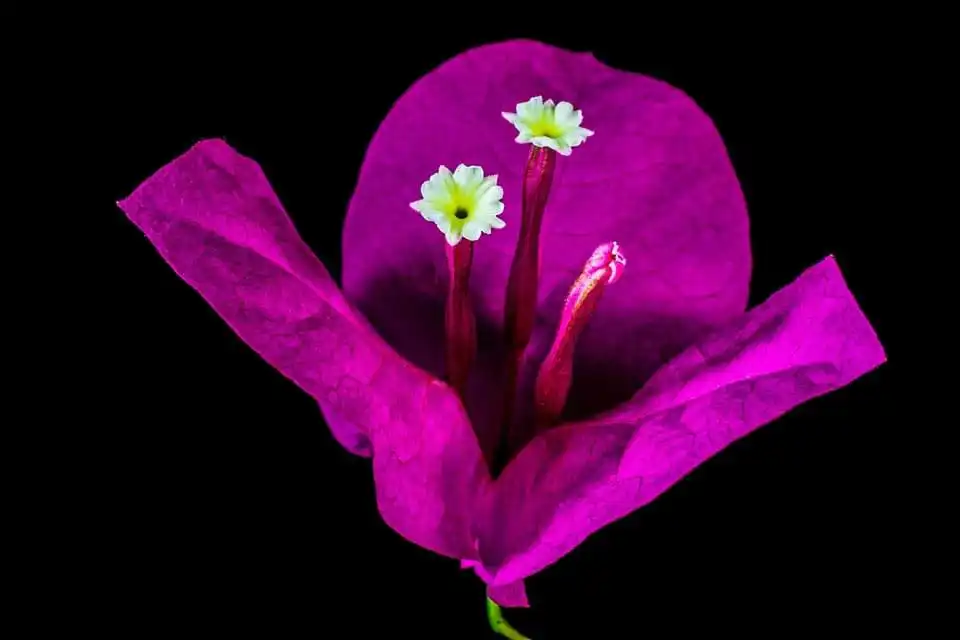
Thorns
One aspect you may not know about the Bougainvillea is that it has thorns. If you’re not careful when pruning the leaves, you might just find one of them prick you. Don’t worry; you won’t die. Also, each species is different with respect to the thorns, and they’ll look different on each one.
We know you may have some concerns, so we’ll quickly address a few of them here. Always be sure to take the proper care when dealing with thorny Bougainvilleas, like wearing gloves and sterilizing the tools before you use them on any other bonsai trees.
Do Bougainvillea Thorns Have Poison?
The main reason you need to be careful when working with Bougainvillea thorns is that it’s mildly toxic. You won’t suffer from a small prick, but any prolonged ingestion can cause you to become sick. Also, you’ll notice a rash or skin irritation from where it touched you for a couple of days. If you see it becoming worse, you need to see a doctor.
Can I Cut Thorns Of Bougainvillea?
While you can cut Bougainvillea thorns, care should be taken that the bonsai tree doesn’t lose too much sap and nutrients. They may be hard to prune, and you may end up damaging the branch and foliage. It’s best to leave the thorns in place and hard prune the branches to encourage more leaves and foliage.
What Happens If You Step On A Bougainvillea Thorn?
When you step on a Bougainvillea thorn, it makes a small hole in your skin that becomes home to pathogenic organisms. These can cause infections, so it’s best to clean the wound with water before closing it. You’ll need to keep a watch on it to ensure that it doesn’t become worse over time.
Is There A Bougainvillea Without Thorns?
You can obtain Bougainvillea tree species that don’t have thorns. The most popular one is “Miss Alice”, with stunning white bracts and flowers that grow quite tall. There are also ones that are semi-thornless with only a few spikes, such as cultivars of Miss Alice called Singapore Pink.
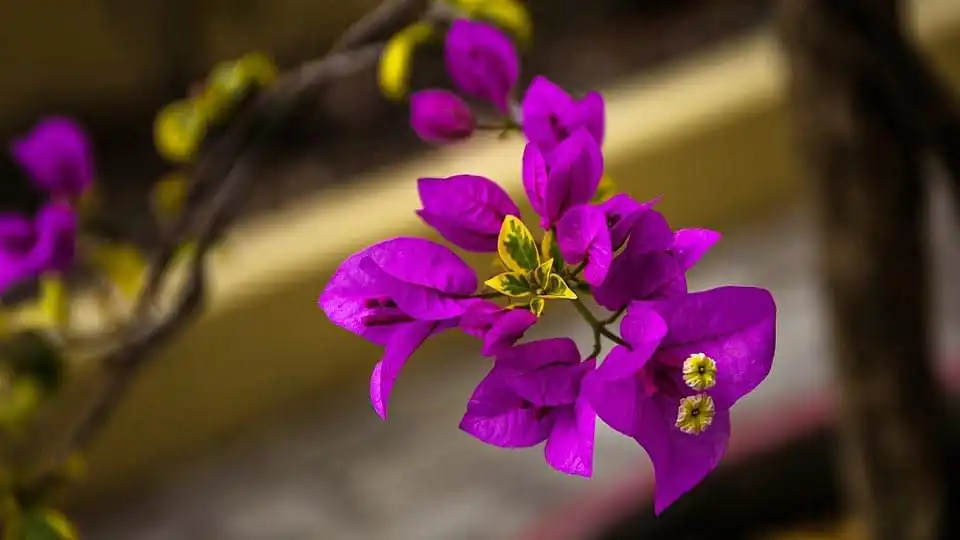
Pruning & Shaping
If you want a healthy Bougainvillea tree that doesn’t spread out too quickly for the size of your bonsai, you’ll need to do some pruning. It involved design and maintenance trimming, which you perform at different times of the year. Each one focuses on a specific aspect, which we’ll cover below.
Another aspect of pruning is working on the shape and style. You can take inspiration from many designs online, but we’ll discuss which ones work the best. We’ll also make sure to include a more detailed article on how you can create various styles with DIY techniques.
Should Bougainvillea Be Pruned?
The Bougainvillea bonsai is renowned for growing vigorously as soon as spring becomes warmer. The vines reach up and climb where possible, extending the reach of the leaves to find as much sunlight as possible. The best way to manage your small tree from developing too quickly is to prune it.
When Should I Prune My Bougainvillea?
In spring, you can aim for maintenance pruning while you can work on the design in winter. These two times will help the Bougainvillea tree to develop more leaves and flowers. However, if you prune in late summer or early autumn, you stand the chance of seeing less blooming when spring arrives again.
How Do You Prune Bougainvillea Indoors?
The best time to prune a Bougainvillea bonsai indoors is during the winter dormancy. You’ll be able to work on the structure while also protecting it from frost. First, remove any dead wood before working on the design you want. You can clear all the leaves if you want, as the tree will develop new ones in spring.
How Do You Prune A Potted Bougainvillea?
Pruning a potted Bougainvillea has two main focus points. The first is the foliage so that the bonsai doesn’t grow too fast too quickly. Secondly, you’ll need to pay attention to the roots when you repot the tree so that they don’t clog the soil and take up all the space in the container.
How Do You Shape A Bougainvillea Plant?
While the bonsai grows quickly and can look wild, it’s easy to develop a shape and design. There are many styles you can apply, which we’ll create a separate article for. For now, we recommend slanting, cascading, formal upright, and informal. Bougainvillea tree shaping is the best way to keep branches and leaves arranged in a stunning form.
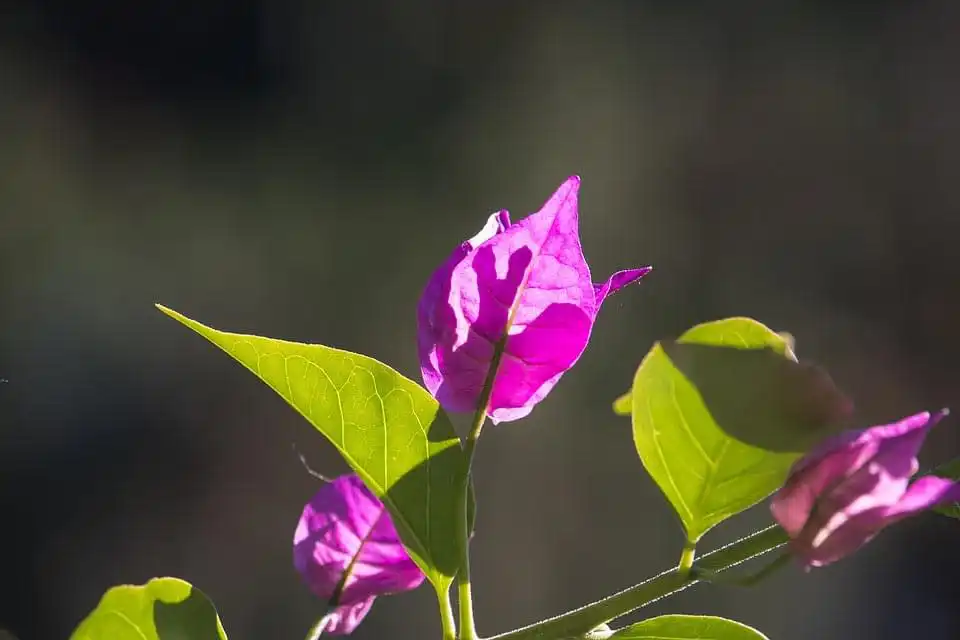
Propagation
Bougainvilleas can be incredibly expensive to buy from the local stores or markets as bonsai trees. While you can get the standard pot or garden plant at a ridiculously low price, the bonsai is much more expensive as someone put a lot of time and energy into cultivating and designing it.
For this reason, you may want to turn to growing your own Bougainvillea tree as a bonsai. We’ll mostly show you various aspects of cuttings, which is the fastest and best way to propagate them. However, you’ll only be successful if you follow the right method.
Can Bougainvillea Grow From Cuttings?
Taking cuttings is the best method to propagate Bougainvilleas. You can do it any time of the year, but we recommend doing it in spring for top results. The sapling may take some time to become used to the pot and new conditions, so don’t give up hope too quickly.
How Do You Take Cuttings From Bougainvillea?
Look for softwood on the tree. Hardwood is too mature to grow successfully from a cutting, and the young stem will more readily feed on the nutrients you provide. It’s also best that you remove as many leaves as possible so that it can focus on root production for the first few weeks.
Will Bougainvillea Cuttings Root In Water?
It’s possible to grow Bougainvillea cuttings in water, but you’re going to wait an incredibly long chance. Also, it isn’t always successful, so we don’t recommend it. If you still plan on doing so, you can add rooting powder to the tip by the cut and place it by direct sunlight. Remember to replace the water once a week so it doesn’t become stale.
Can You Put Cuttings Straight Into Soil?
Your best option for Bougainvillea propagation is placing the cutting directly into the soil. We recommend you place it outside, but you can also use a windowsill for full sun. There needs to be sufficient water, humidity, and ventilation. If you decide to develop it inside, it will take a bit longer.
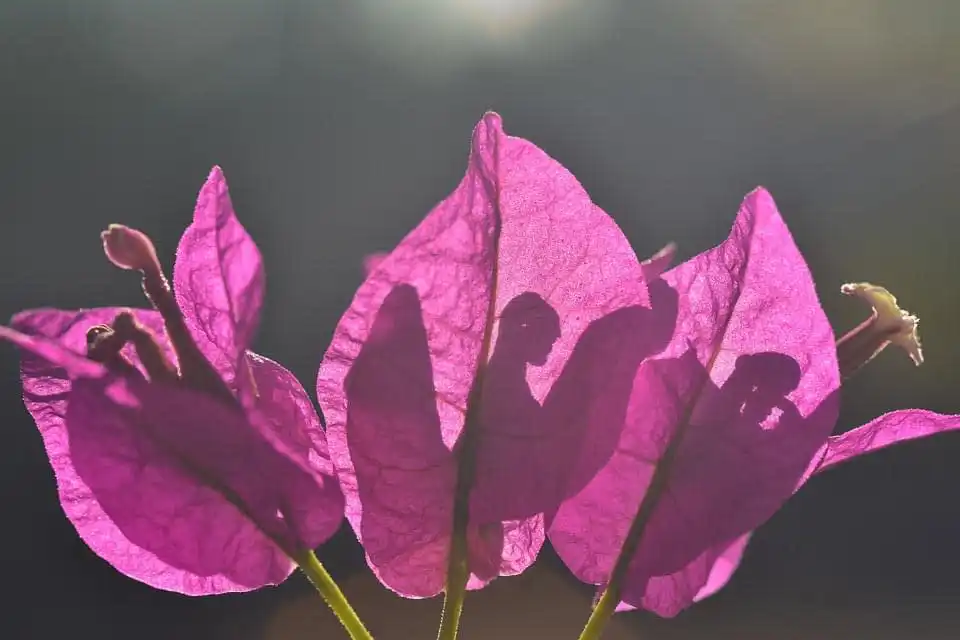
Pests And Diseases
In this final section of Bougainvillea tree care, we’ll discuss pests and diseases that you need to look out for. We’ll try to keep it short, as we have several other articles that cover these aspects in more detail. You’ll also see how you can revive it if it doesn’t look too well and might be dying.
What Kind Of Caterpillars Eat Bougainvillea?
If it looks like something is nibbling on your Bougainvillea bonsai’s leaves, there’s a good chance it’s the Looper caterpillar. They are also known as inchworms. There are different colors, such as brown, green, and yellow, and they move along your tree by bunching up their bodies and stretching out again. After metamorphosis, they transform into the carpet moth.
What Do You Spray On Bougainvillea?
Looper caterpillars multiply quickly, so you may end up with tons of these if you have your bonsai inside the house. Outside, there are some natural predators that may assist you, depending on the location. When all else fails, you can try bacillus thuringiensis or Neem oil. There are also some local pesticides that target these pests.
Why Are There Leaf Spots On My Bougainvillea?
Leaf spots on Bougainvilleas are bacterial, and they usually occur when the humidity is too low or there’s heavy rainfall. They appear black and seem to appear on the leaf veins. If you use overhead irrigation systems, we recommend you change to a different method of watering. They can even cause problems for the bracts.
How Do You Treat Bougainvillea Leaf Curl?
The top reason for leaf curl in Bougainville bonsais is the presence of pests, mostly spider mites. The Looper caterpillar is another culprit, causing the leaves to curl after it starts feeding on it. You’ll need to use a pesticide to kill the pests, but the spray may damage any bracts you have nearby. It’s worth the loss to prevent further damage to your tree.
How Do I Know If My Bougainvillea Has Root Rot?
If you see the bonsai has yellow leaves or they’re falling off in spring and summer, there’s a good chance it has root rot. The only way to solve this disease is to remove it from the soil, clean the roots completely, and replant it in new soil. There’s a chance the condition may not improve and you’ll lose your bonsai.
How Do You Revive A Bougainvillea?
To revive a Bougainvillea bonsai, you’ll need to identify the source of the problem. If you’re watering too much or too little, you’ll need to adjust the frequency depending on how wet or dry the soil is. When sunlight is the problem, either move it to more shade or light. Keep a lookout for any pests, and make sure you’re feeding it enough.
How Do You Treat Bougainvillea Fungus?
If you have an issue with fungus developing on the leaves, you’ll need to remove them from your Bougainvillea bonsai immediately. It will prevent it from spreading all over your tree. You can also spray fungicide to protect it from reoccurring. If it’s in your soil, the only solution is to repot it into new soil and scrub or replace the pot.

General Guide
We know that taking care of your Bougainvillea tree isn’t your only concern. As owners of these bonsais, we had a few questions when we started out, so we jotted a few down that we feel might aid you, especially in the DIY department.
How Do You Turn A Bougainvillea Into A Tree?
While many may see a Bougainvillea as a shrub or creeper, you can train it into becoming a bonsai tree. Many people prefer buying it when it’s mature, but you can also do so from a cutting. As soon as you see it has developed roots in the soil, you need to start maintaining it.
You’ll need to begin from the sapling stage, depending on how large the cutting is you took. If it develops several shoots, choose the strongest one as the main stem and remove the others. All the nutrients will flow up that one to the branches and foliage.
You can use a stake to remind yourself how tall you want the bonsai to grow. When it reaches the correct height, you can cut it a bit lower to start the formation of branches. From here, you can use the clip-and-grow method for ramifications. Remember to remove any of the lower shoots that appear to maintain a neat appearance.
How to Make Bougainvillea Bonsai Tree Step By Step?
Now that you know how to make a Bougainvillea into a tree and the roots have shown, it’s time for us to reveal how you’re going to make a bonsai out of it. Just follow these easy steps, and you’ll soon be able to show it off to your friends:
- Find a proper bonsai pot: First of all, you’ll want a container that matches the glory of your bonsai tree. Key elements you should focus on are shape, depth, and color, while you also need to ensure there are drainage holes. You can read our more detailed article on bonsai pots for more guidance.
- Prepare the new roots: Your new roots will be fragile, so you need to be gentle. If you used the water method to develop them, you can simply make a hole in the new soil and plant it. If you went directly to soil in your trainer pot, you need to dig a ball around the roots and transplant all of it together. It’s best if you wait for the first buds of spring before you do so.
- Decide on an insulator: You’ll want to prevent water from evaporating from the soil quickly. You can either place a transparent bag over it, which will help with humidity, or place mulch or stones on the soil.
- Don’t wire: Bougainvillea trees aren’t fond of wiring, and you’ll end up breaking the young stems. Instead, use the clip-and-grow technique to let it spread out for a bit before cutting it back, promoting new branches.
- Care for your bonsai: Now all you have to do is follow the Bougainvillea bonsai care guide we provided earlier in this article in terms of sunlight, flowers, watering, fertilizer, pruning, and pests.
How Big Do Bougainvillea Trees Get?
In nature, Bougainvillea trees can reach up to 40 ft. if they are not disturbed. If they don’t have the proper support structure, they’ll remain as a low-growing shrub that creeps along the ground. As a bonsai, you can easily maintain it as a small to large tree, depending on your preference.
How Long Does It Take To Make Bougainvillea Bonsai?
Unlike other different types of bonsai trees, the Bougainvillea doesn’t take years to reach maturity and displays numerous leaves and flowers. It settles in quickly, and even cuttings only take a few months before they show good stems. After a few seasons, you should have an exceptional bonsai to present to your friends.
How Fast Does Bougainvillea Grow?
If taken care of, it can develop at a rate of 36 inches per year. As a bonsai, this is an exceptional rate, and you’ll be smiling at how much foliage and flowers it develops in no time. Of course, that means you’ll be spending more time pruning and maintaining it.
What Is The Lifespan Of Bougainvillea?
There are many Bougainvillea trees worldwide that have lived between 50 and 100 years in the wild, while we’ve seen some bonsais reach 55 years of age. The lifespan will depend on several factors, mostly how you maintain its health and changing environmental conditions. The closer it is to its native countries or hardiness zones, the better its chances of living longer.
Is Bougainvillea A Tree Or Shrub?
Bougainvilleas have received many descriptions over the years. While it’s primarily seen as a shrub, many also call it a thorny vine or a small tree. As a bonsai, you can absolutely refer to it as a tree. You’ll be shaping and styling it as one, so the term will be correct.
Is Bougainvillea Annual Or Perennial?
Since the Bougainvillea tree springs back into life every year, it’s perennial. The flowers return once or twice, depending on how much sunlight and food it receives, and it can last you for a lifetime.
How Much Does A Bougainvillea Bonsai Cost?
The price of a Bougainvillea bonsai depends on where you get it. We’ve written an extensive article on how you can expand your collection, and many of the same rules apply. If you purchase online, whether local or international, you can expect to pay a lot, as someone put love and care into developing it for several years.
You may have a better chance at lower rates at your local store, while markets will be even cheaper. Our recommendation is to buy a Bougainvillea for sale as a plant instead of a bonsai, as they will be ridiculously low in price. You can then shape it into a miniature tree. Propagating them from cuttings will cost you nothing.
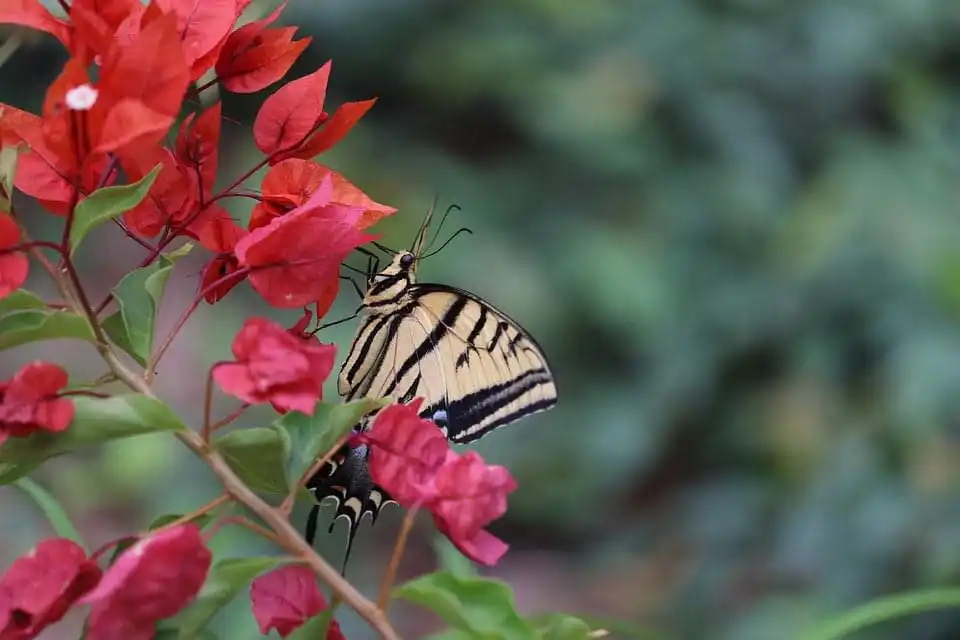
Bougainvillea And Animals
Humans aren’t the only ones fascinated with Bougainvilleas. There are plenty of butterflies, birds, and bees that love them too, specifically because the flowers attract them to the sweet pollen.
However, they aren’t friendly to everyone. There are some animals you need to keep them away from, which begs the questions: should you have this bonsai around your cats and dogs, and are your children safe with them? We’ll cover these queries and more in this section.
Are Bougainvillea Poisonous to Dogs and Cats?
The two aspects you need to watch out for with regards to your Bougainvillea tree and your pets are the thorns and sap. While they are only mildly toxic and won’t kill them, they may end up with gastro problems if ingested, such as nausea and diarrhea. The problem should resolve itself after a few days; if it doesn’t, it’s best to take them to the vet.
Do Hummingbirds Like Bougainvillea?
Hummingbirds love Bougainvilleas for two reasons: they are an excellent source of nectar, and there are plenty of insects after the same food source they can nibble on. They have a terrible sense of smell, so they rely on the colorful bracts to draw their attention. While they are less likely to find your bonsai, don’t be surprised to see them aim for any bushes you have in your garden.
Are Butterflies Attracted To Bougainvillea?
Just like moths and hummingbirds, butterflies adore Bougainvilleas. The nectar is sweet, and the bright colors attract them to your garden. If you have several bonsai trees on display outside, you may find a few butterflies floating around the flowers, investigating to see if there’s any food around.
Do Bees pollinate Bougainvillea Trees?
Since the flower has a long trumpet neck design, the nectar is located at the base where it’s hard to reach. To feed on it, an insect or bird needs a long proboscis or tongue, which bees lack. You’ll more often find hummingbirds, moths, and butterflies around Bougainvilleas than bees, which are the top pollinators for these trees.
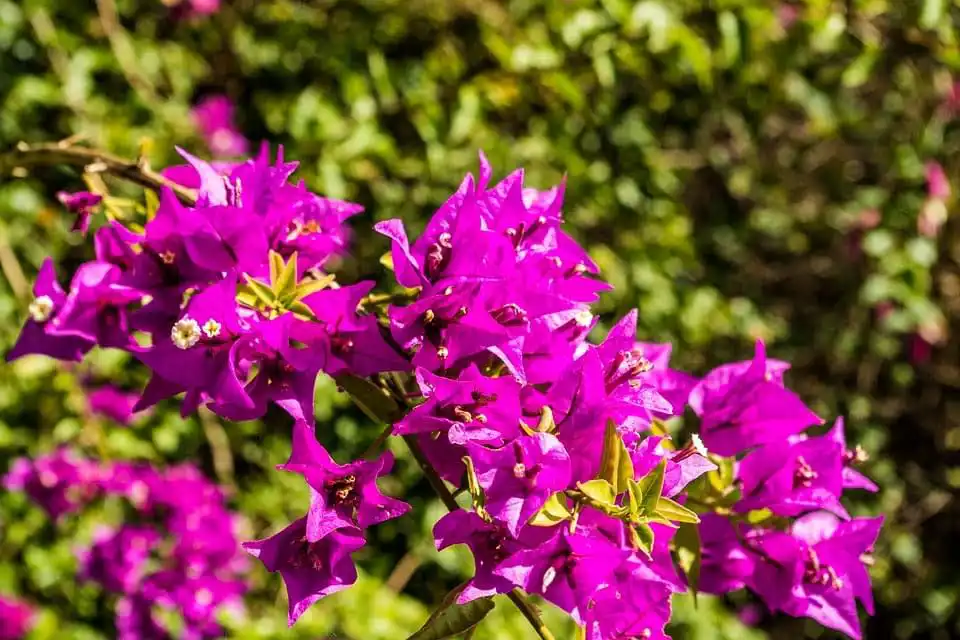
Top Bougainvillea Species
As we mentioned at the start with our Bougainvillea scientific classification, it’s actually a genus of numerous species. Each Bougainvillea variety has a specific appearance and texture, while you can style them in various ways. While there are too many to discuss in great length, we’ll highlight a few of the top ones to grow as bonsai trees.
Is There A Dwarf Bougainvillea?
While you can grow your bonsai to any size, there are some Bougainvillea species that remain dwarf in size compared to the others. A popular variety includes ‘Helen Johnson’, which usually only reaches between 18 and 24 inches. It’s ideal for developing into a bonsai, as you won’t need to worry about pruning it so much.
Bougainvillea Spectabilis
Also called the Great Bougainvillea, this species is native to several South American countries, such as Argentina, Peru, Brazil, and Bolivia. It can reach up to 40 ft. in its natural environment, which is huge compared to other species. The bracts range in color between orange, purple-red, mauve, red, and white.
Bougainvillea Glabra
With an adorable nickname of Lesser Paperflower, the B. glabra is one of the top species to grow as a bonsai since it only grows up to 12 ft. tall. It is resistant to both frost and drought, so it’s incredibly easy to care for in summer and winter. You’ll hardly need to bring it in during winter.
Bougainvillea Peruviana
As the scientific classification implies, the Peru Bougainvillea is native to that specific country in South America. Bract colors you may find include purple, magenta, and pink. They do well in hardiness zones 9 through 13, being able to handle some of the warmer climates. However, it’s not fond of being indoors during summer, so it’s best to grow this species outside.
Bougainvillea Rosenka
An absolutely gorgeous Bougainvillea, its bracts start with a golden color before shifting to a soft pink. It has a mounding habit with the foliage, much like some junipers, and they remain small enough to grow as bonsai. The main concern is that it only thrives in zones 10 and 11, so it needs more protection from heat and frost than the other species.
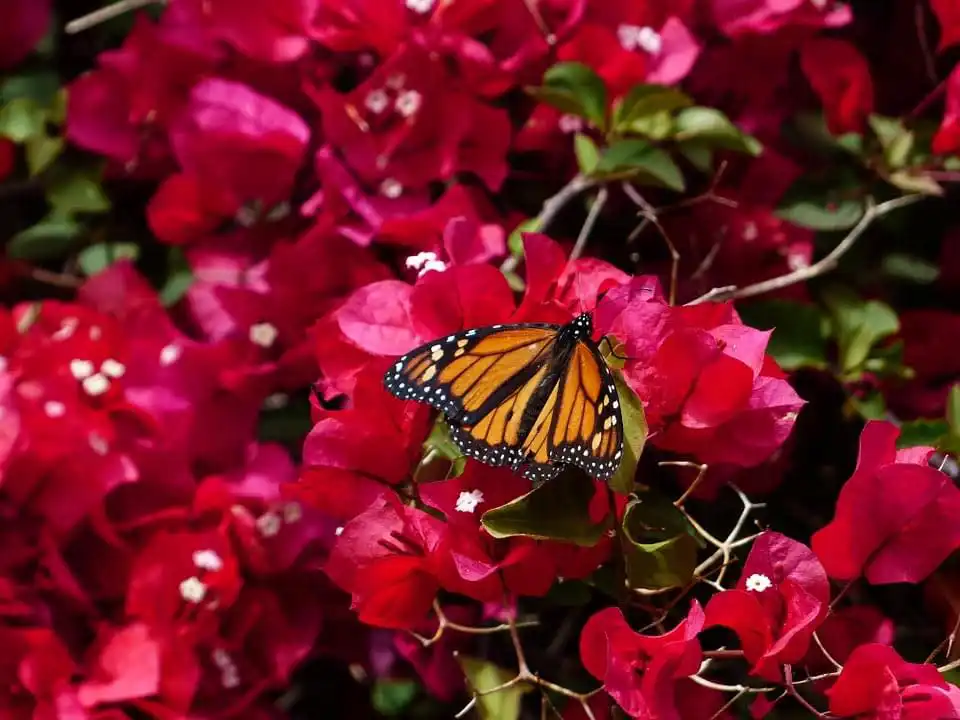
Inspiration For Your Bougainvillea Bonsai
Before we end this outstanding article on the Bougainvillea bonsai tree, we’d like to show you where you can obtain inspiration for styling them. These are simply short highlights, and we’ll direct you to our other articles that cover specific sources you can look at in detail.
If you’re wondering what you should do with your Bougainvillea, we invite you to check out some Instagram profiles. There are plenty of bonsai developers who enjoy showing off what they’ve managed to accomplish. While we recommended some accounts, you should also check out the tags #bougainvillea and #bougainvilleabonsai.
Another option for bonsai inspiration is YouTube. You’ll find loads of content creators ready to show you how to take care of these trees and shape them into various styles. You may just get some ideas for your own designs.
Final Thoughts
Thank you for bearing with us in our guide on the Bougainvillea tree. As you can see, there’s a lot to cover, as it’s such a wonderful genus with so many factors to consider. We also included as many questions as we could find regarding these gorgeous trees so that you don’t have to hunt the internet for them.
If you have any other queries we haven’t covered, please feel free to comment or send us an e-mail. We always love hearing from you when you engage with our content, and we want to keep the communication open.







